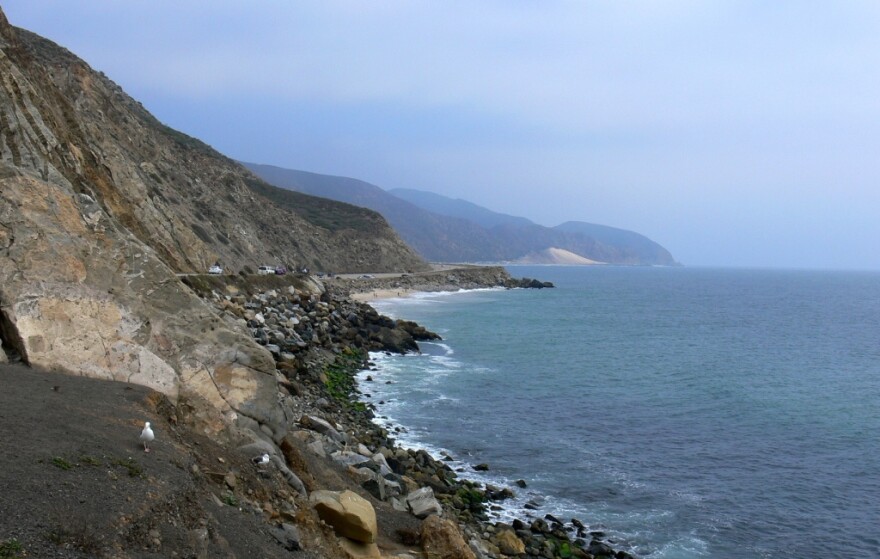This archival content was originally written for and published on KPCC.org. Keep in mind that links and images may no longer work — and references may be outdated.
Fukushima FAQ: 5 things you should know about water from the disaster

It's been three years since an earthquake and resulting tsunami caused a partial meltdown at the Fukushima Daiichi Nuclear Power Plant in Japan.
The first traces of sea water contaminated by that disaster are expected to reach California sometime this year.
RELATED: Scientists test kelp for traces of Fukushima radiation
There are lots of questions about how ocean water from Fukushima will affect California. Here are some answers.
When will water from Fukushima reach Southern California?
Researchers have already found small amounts of cesium-134 and 137 off the coast of British Columbia in Canada. Those isotopes have been linked to the Fukushima partial meltdown.
The cesium was likely carried by the trans-Pacific Kuroshio Current. The coastal California Current is expected to transport that water south all the way to the Baja peninsula.
Ken Buesseler, a senior scientist with the Woods Hole Oceanographic Institution in Massachusetts, says there are three models predicting how this water will travel. The earliest prediction has it arriving around April; the latest prediction has it coming in the second half of the year.
Watch: Fukushima plume prediction
Will the water be hazardous when it gets here?
Not likely, says Phyllis Grifman with USC's Sea Grant Program.
She and other researchers studying ocean radiation say by the time any nuclear material from Fukushima reaches California, it will be so diluted that it will not pose a health risk to humans.
However, to make sure there is no threat, Sea Grant helped fund Kelp Watch, a West Coast-wide survey to measure cesium levels in kelp. Researchers have already collected an initial sampling of kelp and will test it for nuclear material.
They will take additional samples later in the year to note any changes in cesium levels.
Grifman says if cesium levels turn out to be higher than expected, it could impact the marine eco-system since many animals depend on kelp. If that's the case, researcher will conduct further tests to assess the situation.
The Woods Hole Oceanographic Institution has a similar project to monitor seawater. They have a website where members of the public can suggest sites for testing and learn more about how nuclear material affects our ocean.
What about people detecting radiation on beaches with geiger counters?
There was a video from December in which a man in Northern California detects increased radiation levels using a geiger counter on the beach.
It has hundreds of thousands of views on YouTube, but Ken Buesseler explains the radiation most likely comes from "thorium-bearing minerals that are common and often elevated in some beach sands."
He says there is a lot of relatively harmless naturally occurring radiation in the environment.
A study from UC Berkeley shows that scientists have been aware of the natural radiation at beaches since at least 1959.
Is it safe to eat fish from the Pacific Ocean?
Fisheries around Fukushima remain closed due to high cesium levels in some fish, especially bottom dwellers. This has been difficult for that part of the Japanese seafood industry.
Many of the affected fish are smaller varieties and do not travel far from Japan.
However, larger fish like the Pacific bluefin tuna can travel long distances and might pick up cesium from feeding grounds off the coast of Japan.
While some of these tuna may show traces of cesium, it has been observed to be lower than levels of other naturally occurring radioisotopes in those fish and it's considered far below the levels that would worry the FDA.
There have been peer-reviewed studies backing this up, and as Kim Martini of the University of Washington explained in a report on "PRI's The World," a person would have to eat 2.5 tons of tuna a year to get a harmful dose.
“I really love tuna, but I don’t love it that much,” Martini said.
How long will the radiation last in our ocean?
A long time.
The half-life of cesium-134 is around 2 years, while the half-life of cesium-137 is about 30 years. That means it could linger for decades or even centuries, according to Ken Buesseler.
Remnants of nuclear weapons testing in the 1960s and '70s are still detectable around the world.
Around 400 metric tons of contaminated water from the Fukushima nuclear plant continues to enter the ocean every day. Tepco, the company responsible for the plant, is working on solutions to this problem but there doesn't seem to be an easy fix.
As noted above, most researchers do not think this poses an immediate threat to people outside the area around the plant. However, this event is unprecedented and that's why scientists will continue to monitor the situation to see if there are any changes in the risk to human health and the environment.
